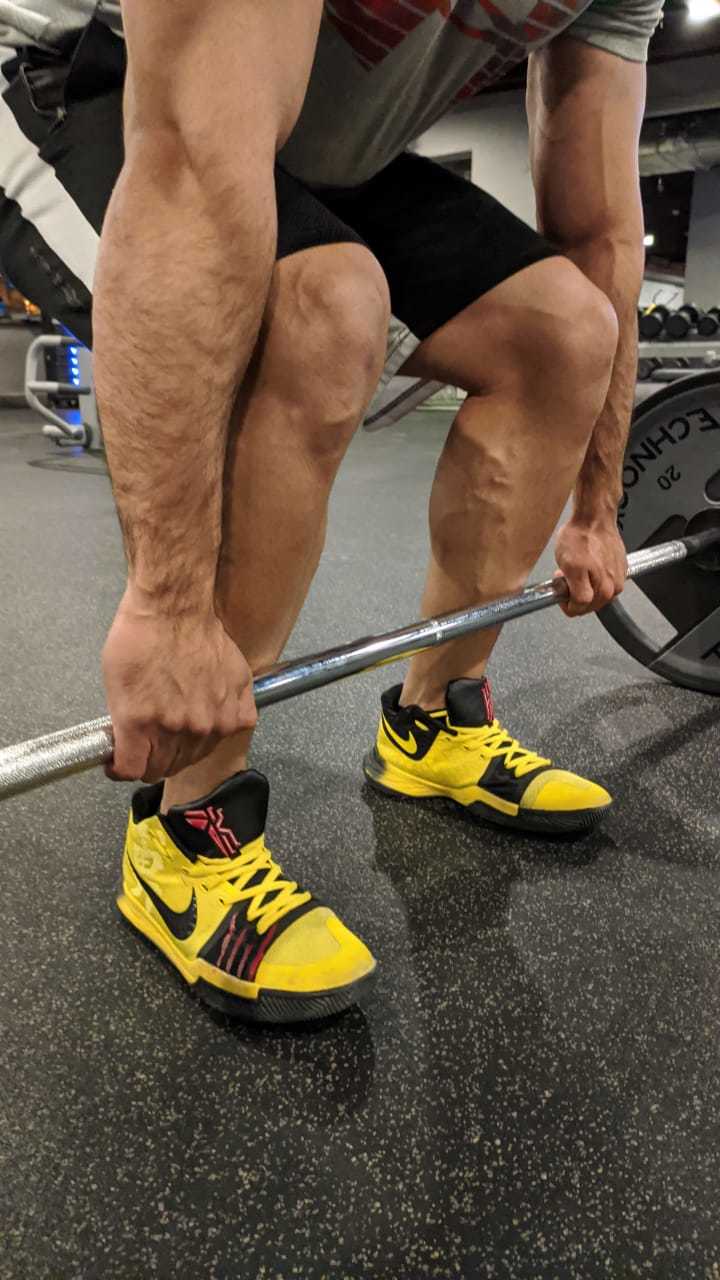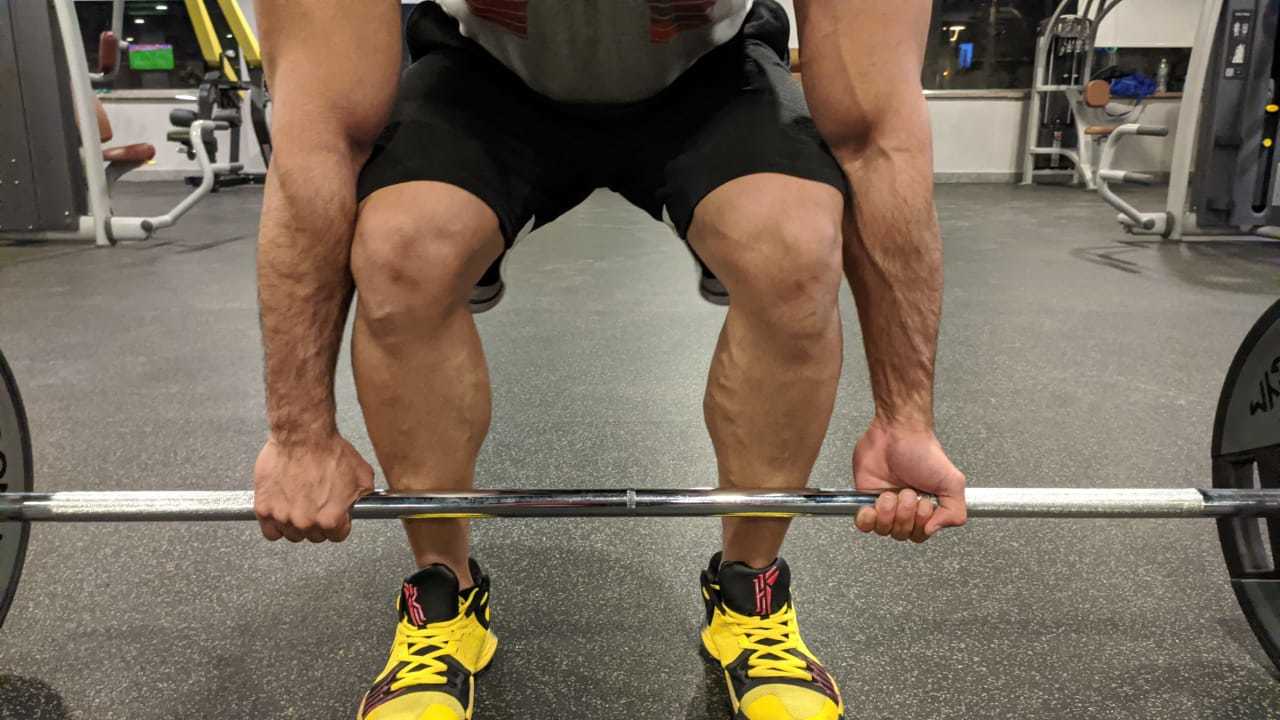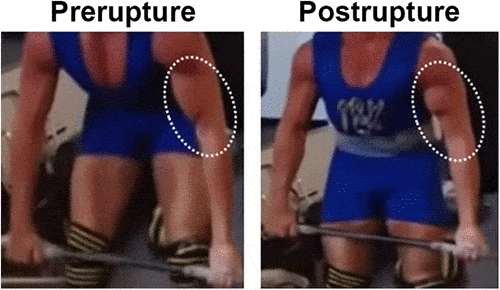Some links in this article are affiliate links, which means I earn from qualifying purchases.
The deadlift is known by many as the king of the lifts.
The deadlift grip acts as an intermediary to perform the lift and engage the muscles of the forearms, lower and upper extremities (1).
There are a variety of grips and accessories that can be employed but are accompanied with many pros and cons, therefore you can pick a grip based on your specific needs (1).
So how can you maximize your deadlift grip? The best deadlift grip for you will depend on your overall lifting goal. For most lifters, the overhand grip is the safest and most effective. To maximize the deadlift grip center yourself with the loaded bar and grasp it with the middle of the palm. Lastly, it is important to incorporate exercises to developing hand grip, such as grip strengtheners, farmers carry and towel pull-ups.
The 4 exercises to improve deadlift grip are:
Let's start with the types of deadlift grip before we talk about all of these exercises in detail.
Deadlift Grip: The 5 Main Types
1. Double Overhand Grip
The double overhand grip is my personal favorite for deadlift and I would recommend it to recreational lifters and bodybuilders using a moderate-high intensity.
However, this grip probably is not the suited for competitive powerlifters, that I will highlight later in this article.
The double over hand grip requires the palms to be pronated (palms down) with the fingers and thumb tightly wrapped around the bar at shoulder width apart (2).
Grasping the bar would be Followed by drawing in the set-up position, which you can learn from my article called ‘Deadlift Back Angle’.

Pros
Safety
The double overhand grip is one of the safest grips as it stretches the muscles of the stronger brachialis muscles which are located underneath the bicep and produce the flexion at the elbow with the palms facing a pronated position (1, 2).
The brachialis is generally a lot stronger and injury resistant compared the Bicep Bracci which is drawn during other alternative grips (2).
Beginner Friendly
The double overhand grip is easy to learn and perform for beginners as it is a natural grip in terms of finger and thumb positioning.
Cons
Not Great For High Intensity Lifts
In my personal experience, at higher intensities of 85-100% 1RM, there is an increased chance of losing grip as the muscles around the forearm may not being strong enough, especially with smaller hand sizes.
2. Mixed Deadlift Grip
The mixed grip differentiates to the double overhand grip as one of the hands would be pronated and the dominant arm would be supinated (underhand) (2).
Due to the injury risk, I probably would not recommend this grip unless the lifter was observing lower intensities with higher reps to induce endurance/ sarcoplasmic-based hypertrophy (3).

Pros
Stability
The mixed grip prevents forward rotation of the bar, therefore allowing for more stability and a smoother lift (1).
Cons
Injury Risk
Its very common for those engaging in the mixed grip, to ramp up the intensity and subconsciously jerk/flex the bicep in order to complete the lift (2).
This motion puts natural stress on the bicep tendon, imagine trying bicep curl 330lbs. You must have come across clips where the big guy tries to hit a personal record, only for his bicep to rip off its insertion point (crease of lower arm).
It's better to either drop the intensity or opt for another hand grip. In support of the notion, I am going to refer to a peer reviewed study conducted in 2021 by Kapicioglu et al. who observed distal bicep ruptures on YouTube and found 35 injuries.
From these injuries, 25 occurred during the deadlift and 24 of these while using the mixed grip on the supinated arm, as you can see from the figure bellow extracted from the same study.

Modified from Kapicioglu et al. (2)
Muscle Imbalance
Due to the nature of the grip one of the biceps and one of the brachialis would be activated unevenly, and if the mixed grip is used frequently, you could expect some muscle imbalances.
3. Hook Grip
The name of this grip stems from the hooked thumb positioning.
Specifically, where you would start by placing the palms on the bar, similar to a double overhand grip. However, instead of clenching the bar right away, you would hook the thumb underneath and bar around as possible, and clench the fingers around the bar (4).
This a great alternative grip for most competitive power lifters as it offers tight grip, almost replicating a lifting strap which is prohibited in powerlifting meets.
Pros
Great Alternative For Competitive Powerlifters
As mentioned, lifting straps are prohibited during powerlifting competition, not to mention that they would not allow a lifter to maximize grip strength from nullifying some of the grip engagement (4).
For this reason, the hook grip is the ‘go to’ for powerlifters or those aspiring as it improves grip strength and offers a substantial amount of grip.
Safer Than Mixed Grip
The hook grip is just another variation of the double overhand grip and does not place the same tension on the bicep tendon (2).
Cons
Thumb Injuries
Its normal to experience some thumb discomfort, skin tears and at worst fractures as there would be a considerable amount of pressure and/or friction on the thumb.
4. Double Underhand Grip
A less common grip is the double underhand, which requires you to grasp the bar with both hands underneath the bar (supinated).
The nature of the grip puts greater emphasis on the biceps and lower latissimus dorsi muscle fibers, as well as the lower extremities (2).
I have never had the need to use the double underhand grip, but I would only employ it with lower intensities and higher reps to induce more sarcoplasmic hypertrophy (muscle).
My theory is that the double grip is underused and lifters do not tend to use it for maximal deadlifts or that we would see a lot more bicep injuries and ruptures.
In fact the right arm bicep rupture of 6 times Mr. Olympia Dorian Yates occurred while performing high intensity double underhand back rows that shares some similarities in terms of grip and some joint actions.
Pros
Increased Activation
The double underhand grip applies more stress on the biceps via an isometric contraction and also the lower lats vertical adduction movement (2).
Cons
Injury Risk
It's difficult to prove, but based on my expertise and anecdotal analysis there is a greater chance of distal bicep ruptures, with increased risk at higher intensities (2).
5. Double Semi Pronated Grip
The double semi pronated grip can only be used during a dumbbell or chamber/hexagon bar deadlift and in my opinion allows you to rack up significantly more weight on the bar.
In order to utilize this grip, you must center yourself within chamber bar or set up a pair of dumbbells to each of your sides in a vertical position (5).
You would then clinch the bar or the dumbbells similar to the double overhand grip.
This grip differentiates from the other alternative as it activates the brachioradialis muscle which is located at the medial side of the lower arm (5).
Pros
Adds Variation
At times, the barbell deadlift can get tedious and reduce motivation, so it is always important to add some variation to keep those motor units firing for progressing (6).
Targets The Brachioradialis
The brachioradialis is activated by flexion of the elbow when the arm is in a semi pronated position, in the case of the chamber bar deadlift the brachioradialis is activated isometrically (5).
Deadlift Grip Aids
Even if you can't grip the bar at heavier weights with any grip, there are multiple equipment pieces you can use to help.
1. Lifting Wraps
A lifting wrap is a long cut strap that come in a variety of materials like leather or cloth.
It hooks onto the wrists and underneath a loaded bar, in most cases amalgamated with a double overhand grip (4, 7, 8).
Lifting wraps act in a similar manor to the hook grip but much more effective in terms of grip (4, 7).
Pros
Increases Lifting Intensity And Volume
The lifting wraps are my ‘go to’ when it comes to the deadlift as they add 30-40lbs to my deadlift. However, note my goal is not to compete in powerlifting or improve grip strength, solely to increase muscle strength and size, so I engage in anywhere from 2-12 reps.
A recent study Jukic et al. analyzed the effect of the lifting wraps on maximal force production during the deadlift. The researchers recruited 18 resistance trained male participants to perform 2 sessions of deadlift.
The deadlift with lifting wraps produced a mean 1 rep max of around 394lbs (1RM = 179.0 ± 29.9 kg) and 357lbs without (1RM = 162.0 ± 26.9 kg), give or take that’s a that’s a 37 pound difference!
Low Cost Accessory
I just opt to buy the regular cotton wraps that can cost less than 10 USD, that’s a small investment considering it can add 40lbs to your 1RM.
Cons
Hinders Grip Strength Development
You could say that the lifting wraps nullify the effort you would normally apply onto gripping the bar, therefore you will engage and develop the key areas to a much lesser extent (4, 7, 8).
This is definitely not recommended for powerlifters as they are required to maximize their grip strength for 1RM deadlifts (7).
Moreover, for those who are looking to improve grip strength could alternate between using lifting wraps, chalk and no application.
2. Lifting Chalk
Lifting chalk can be purchased in a Powder and liquid, form my personal preference is the liquid form as it dries onto the hand and does not cause as much mess.
It creates a dry hand surface and increases friction between the hand and bar, thereby improving grip (4).
Pros
Improved Deadlift Grip Acutely
During exercise the palm can get sweaty which reduces the bar grip, as chalk creates a dry surface it increases friction and grip as mentioned (4).
Low Cost Accessory
You can’t go wrong with an investment of under 10 USD to improve your deadlift grip.
Cons
Can Get Messy
Chalk especially in the powered form can disperse and spread around the gym floor, which other gym users and workers would probably not appreciate.
Which Deadlift Grip Is Best For You?
Bodybuilders And Recreational Lifters
Without a doubt, the ‘best’ deadlifting grip for bodybuilders and recreational lifters is either the double overhand or the double semi pronated grip (8).
Combining this grip with lifting wraps at moderate-high intensity to maximize lifting volume and chronically improve physical shape/functional performance (8).
The only downfall with this type of grip is that it hinders the development of grip strength, as you could say that the lifting wraps absorb a lot of the tension (4, 7).
For this reason, you could devote deadlift days focusing on griping the bar without being aided by the lifting wraps. You could also refrain from using the lifting wraps for other lifts like the back rows and Lat pulldown to tap into some of that grip strength.
Competitive Powerlifters And Strongman
The hook grip is the ‘best’ for competitive powerlifters as it improves grip strength and is specific to the powerlifting deadlift. Whether you prefer sumo or conventional deadlift.
Especially in competitions where lifting wraps are prohibited (4).
Other than the hook grip, I would not recommend an alternative grip, unless the lifter has experienced a finger or thumb injury. In this case, a modified double overhand or semi pronated grip could be used with lifting wraps to reduce pressure on the injury.
The lifter can rehabilitate and still perform the lift to maintain strength and motor unit recruitment.
I remember a time when I broke my right hands index finder and could not grip the bar. To still deadlift, I utilized lifting wraps and modified the double over hand grip by elevating the finger and removing all of the pressure.
However, its best to consult your physiotherapist to assess your injury prior to attempting this method.
How To Set Up An Effective Deadlift Grip
1. Grip The Bar Evenly
You must center yourself on the bar and grip the bar with the arms spread evenly apart or you would lose grip from an uneven bar (9).
2. Center The Palms To The Bar
To maximize your Deadlift grip, you must center your palm on the bar allowing you to wrap the fingers and thumb around (9). If you place the bar too far away from the palm, chances are that you would lose grip where the bar would slip out of your fingers (9).
3. Build Your Grip strength And Lifting Technique Gradually
You don't want to jump right away to mixed grip during heavier loads. Take the time to build proper grip strength and lifting technique and get your muscles used to the new position.
It may feel awkward at first so you don't want to overload the new position and potentially get injured.
The biomechanics of the mixed grip deadlift differ slightly from the regular grip. You want to get used to it at a lighter weight first. Also, because it is harder to keep your spine neutral, you want to master the mechanics first before switching to heavier loads.
4 Exercises For Developing Deadlift Grip Strength
1. Grip Strengtheners
You must have come across one of those spring-loaded grip devices.
I remember when I started out in the gym I could not even grip 100lbs on the barbell without it slipping. I started performing grip clenches on a daily basis and my grip strength improved significantly, where I could firmly grip 240lbs within 3-4 weeks.
How To Perform
2. Farmer's Walks
The farmers walk requires you walk with a load of around 70% deadlift intensity (11).
There's is a variety of equipment options such as; Dumbbells, Chamber bar, Kettlebells and even sandbags.
This exercise gets gruelingly painful as lactate starts to build up and activates the muscles of the whole body, as well as grip improving grip strength, balance and co-ordination (11).
How To Perform
3. Towel Pull Ups
The towel pull-up is basically a pull up but you could say you are using a towel as an attachment, oppose to conventional pull ups (12).
The towel pull ups are great because they really target the grip strength muscles as well as the lower portion of the latissimus Dorsi, due to pulling up with the upper arm in a vertical position (12).
How To Perform
4. Rope Climbing
Rope climbing is very similar to the towel pulls, but may differentiate as the girth of the rope is thicker which will draw more grip engagement and may even be more beneficial (13).
How To Perform
Frequently Asked Questions
What Is The Best Deadlift Grip?
A tight overhand grip wrapped firmly underneath and around the bar, which could probably add 30-40lbs to your lift.
What Is The Safest Deadlift Grip?
Again, I stress that the safest deadlift grip is the double overhand or the semi pronated grip, this is due to the supinated grip increasing distal bicep tendon rupture risk and the hook grip can cause thumb injuries.
Do You Recommend The Mixed Grip?
I really am not a fan of this at all, but if I was to use it, it would with a low intensity and a thorough observation of my deadlift form to avoid jerking the arm.
How Do I Work Around A Hand Injury While Trying To Deadlift Grip The Bar?
I would advise you to consult your physiotherapist, but in the past, I have experienced a broken finger where I utilized the lifting wraps. The lifting wraps are so effective that you hardly need to apply any effort while gripping the bar.
Will The Deadlift Grip Affect How You Build Strength And Muscle?
The short answer is YES! I you are able to form an adequate grip, chances are you will be able to maximize intensity and volume, thus chronically developing strength and muscle. Moreover, different grips will allow you to target slightly different muscles of the arm, the underhand based grip would tap into the biceps, whereas the overhand grips would stimulate the brachialis and lastly the semi pronated grip would stimulate the brachioradialis.
Final Thoughts
The ‘best’ grip will entirely depend on personal preference and goal.
For the bodybuilder or recreational lifter, a double overhands or semi-pronated grip with chalk or lifting wraps would be beneficial for muscle and functional improvement.
On the other hand, for the competitive powerlifters, a hook grip would be more specific. I probably would not recommend the mixed or underhand grip due to the injury risk, unless lower intensities are observed.
To form an adequate grip the lifter must be centered to the loaded bar with the arms equally apart and grasping it from the middle of the palm, warping the fingers and thumb around firmly.
Lastly, it is important to incorporate exercises into your training program that focus on developing hand grip, such as; the grip clinches, farmers carry and towel pull-ups.
DISCLAIMER: This article is for intended for educational purposes only and not as an individualized exercise prescription, therefore no one can be held liable in the occurrence of injuries, damages or monetary losses as a result of the information.
References
1. Pratt, J., Hoffman, A., Grainger, A., et al. Forearm electromyographic activity during the deadlift exercise is affected by grip type and sex. Journal of Electromyography and Kinesiology. 2020;53 (1): 102-122
2. Kapicioglu, M., Bilgin, E., Guven, N. The Role of Deadlifts in Distal Biceps Brachii Tendon Ruptures: An Alternative Mechanism Described With YouTube Videos. Orthopaedic Journal of Sports Medicine. 2021; 9(3): 1-6
3. Scoenfeld, B.J. Potential Mechanisms for a Role of Metabolic Stress in Hypertrophic Adaptations to Resistance Training. Sports Medicine. 2013; 43 (3):179-194
4. Jukic, I., Ramos, G.A., Balas, J., et al. Ergogenic effects of lifting straps on movement velocity, grip strength, perceived exertion and grip security during the deadlift exercise. Physiology and Behaviour. 2021; 229 (1): Published ahead of print
5.Swinton, P.A., Stewart, A., Agouris, I, Keogh, J.W.L., Lloyd, R., A Biomechanical Analysis of Straight and Hexagonal Barbell Deadlifts Using Submaximal Loads, Journal of Strength & Conditioning Research, 2011, 25(7).
6. Baz-Valle, E., Schonefeld, B.J., Torres-Unda, J., et al. The effects of exercise variation in muscle thickness, maximal strength and motivation in resistance trained men. Plos one. 2019; 14(12): e0226989
7. Kenedy, C.A. The Influence of the closed grip, hook grip and lifting straps on kinetic, kinematic and qualitative performance variables of the power snatch. 2020; Doctoral Thesis, the Auckland University of Technology
8. Jurkic, I., Garcia-Ramos, A., Malacek, J., et al. Validity of Load-Velocity Relationship to Predict 1 Repetition Maximum During Deadlifts Performed With and Without Lifting Straps: The Accuracy of Six Prediction Models. Journal of Strength and Conditioning Research. Published ahead of print.
9. Beckham GK, Lamont HS, Sato K, Ramsey MW, Haff GG, Stone MH. Isometric strength of powerlifters in key positions of the conventional deadlift. Journal of Trainology. 2012;1(2):32-35.
10. Wichelhaus, A., Harms, C., Neumann, J., et al. Parameters influencing hand grip strength measured with the manugraphy system. BMC musculoskeletal disorders. 2018; 19 (54):1971-1974
11. Windwood, P.W., Cronin, J.B., Brown, S.R., et al. A Biomechanical Analysis of the Farmers Walk, and Comparison with the Deadlift and Unloaded Walk. International Journal of Sport Science and Coaching. 2015; 9 (5): 1127-1143
12. Akter, S. MEASUREMENT OF HAND GRIP STRENGTH BY DIGITAL JAMAR HAND DYNAMOMETER: A STUDY ON CRP STAFFS & BHPI STUDENTS. Bachelor thesis, University of Dhaka
13. Draper, N., Jones, G.A., Fryer, S., et al. Physiological and psychological responses to lead and top rope climbing for intermediate rock climbers. European Journal od Sport Science. 2010; 10 (1):13-20
About The Author

Zack Shakoor Kayani was born and raised in the South East of England/London. Zack has attained a bolus of knowledge regarding biosciences through academia and his career experiences. In terms of his educational background, he has a Bachelor of Science in Kinesiology (Hons.), a Postgraduate diploma in sports nutrition with the International Olympic Committee, and a Master’s of Science in Nutritional Sciences. Zack has been fortunate enough to apply his Exercise Science and Nutrition Knowledge to aid Hundreds if not Thousands of Patients and Athletes, providing 1-1 consultation, Personal training, Information sheets, offering recommendations to collate nutrition and exercise programs, etc. Not to mention, in 2020, he authored a book called ‘Obesity Decoded’.





